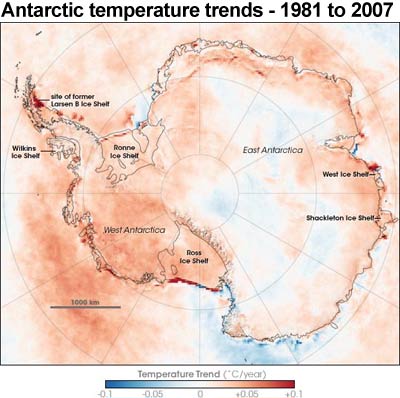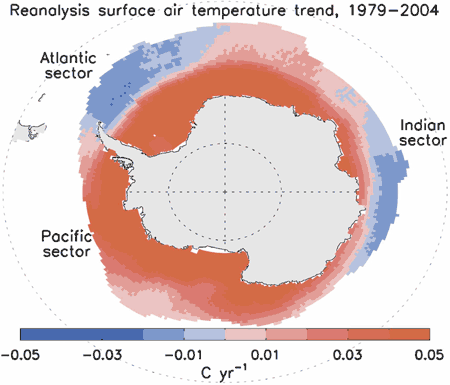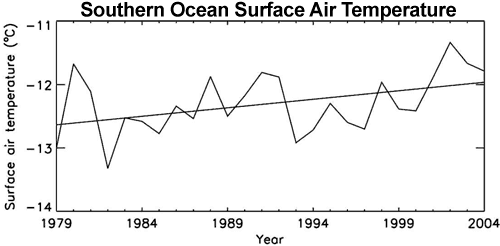
Figure 2: Antarctic surface temperatures as observed by satellites between 1981 and 2007.
What The Science Says:
Antarctic sea ice has been growing over the last few decades but it certainly is not due to cooling - the Southern Ocean has shown warming over same period. Increasing southern sea ice is due to a combination of complex phenomena including cyclonic winds around Antarctica and changes in ocean circulation.
Climate Myth: Southern sea ice is increasing
'Antarctic sea ice set a new record in October 2007, as photographs distributed by the National Oceanic and Atmospheric Administration showed penguins and other cold-weather creatures able to stand farther north on Southern Hemisphere sea ice than has ever been recorded. The news of expanding Antarctic sea ice stole headlines from global warming alarmists who asserted Arctic sea ice had reached its lowest extent since 1979.' (James Taylor)
The most common misconception regarding Antarctic sea ice is that sea ice is increasing because it's cooling around Antarctica. The reality is the Southern Ocean surrounding Antarctica has shown strong warming over the same period that sea ice has been increasing. Globally from 1955 to 1995, oceans have been warming at 0.1°C per decade. In contrast, the Southern Ocean (specifically the region where Antarctic sea ice forms) has been warming at 0.17°C per decade. Not only is the Southern Ocean warming, it's warming faster than the global trend. This warming trend is apparent in satellite measurements of temperature trends over Antarctica:

Figure 2: Antarctic surface temperatures as observed by satellites between 1981 and 2007.
Similar trends are found when combining temperature data measured from ships and buoys. The following figure from Increasing Antarctic Sea Ice under Warming Atmospheric and Oceanic Conditions (Zhang 2007) displays trends over the ice-covered Southern Ocean - this is the region where Antarctic sea ice forms.

Figure 3: Linear trend (1979–2004) of surface air temperature over the ice-covered areas of the Southern Ocean (Zhang 2007).
We see strong warming over most of the ice-covered Southern Ocean although there is also some cooling. What is the average trend over the whole region? The overall surface temperature trend over the ice-covered regions of the Southern Ocean shows a warming trend:

Figure 4: Annual mean surface air temperature averaged over the ice-covered areas of the Southern Ocean. Straight line is trend line (Zhang 2007).
Oceanographic data also find that the waters in the Southern Ocean are warming. The waters of the Southern Ocean's Antarctic Circumpolar Current have warmed more rapidly than the global ocean as a whole. From 1960 to 2000, water temperature increased by 0.068°C per decade at depths between 300 and 1000 metres. This warming trend has increased to 0.098°C per decade since the 1980s (Boning 2008).
If the Southern Ocean is warming, why is sea ice increasing? There are several contributing factors. One is the drop in ozone levels over Antarctica. The hole in the ozone layer above the South Pole has caused cooling in the stratosphere (Gillet 2003). A side-effect is a strengthening of the cyclonic winds that circle the Antarctic continent (Thompson 2002). The wind pushes sea ice around, creating areas of open water known as polynyas. More polynyas leads to increased sea ice production (Turner 2009).
Another contributor is changes in ocean circulation. The Southern Ocean consists of a layer of cold water near the surface and a layer of warmer water below. Water from the warmer layer rises up to the surface, melting sea ice. However, as air temperatures warm, the amount of rain and snowfall also increases. This freshens the surface waters, leading to a surface layer less dense than the saltier, warmer water below. The layers become more stratified and mix less. Less heat is transported upwards from the deeper, warmer layer. Hence less sea ice is melted (Zhang 2007).
Antarctic sea ice is complex and counter-intuitive. Despite warming waters, complicated factors unique to the Antarctic region have combined to increase sea ice production. The simplistic interpretation that it's caused by cooling is false.
Intermediate rebuttal written by John Cook
Update July 2015:
Here is a related lecture-video from Denial101x - Making Sense of Climate Science Denial
 |
The Skeptical Science website by Skeptical Science is licensed under a Creative Commons Attribution 3.0 Unported License. |